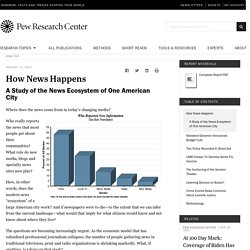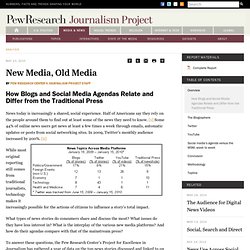

How News Happens. Where does the news come from in today’s changing media?

Who really reports the news that most people get about their communities? What role do new media, blogs and specialty news sites now play? How, in other words, does the modern news “ecosystem” of a large American city work? And if newspapers were to die—to the extent that we can infer from the current landscape—what would that imply for what citizens would know and not know about where they live? The questions are becoming increasingly urgent. The answers are a moving target; even trying to figure out how to answer them is a challenge. The study, which examined all the outlets that produced local news in Baltimore, Md., for one week, surveyed their output and then did a closer examination of six major narratives during the week, finds that much of the “news” people receive contains no original reporting.
And of the stories that did contain new information nearly all, 95%, came from traditional media—most of them newspapers. 1. 2. New Media, Old Media. News today is increasingly a shared, social experience.

Half of Americans say they rely on the people around them to find out at least some of the news they need to know. [1] Some 44% of online news users get news at least a few times a week through emails, automatic updates or posts from social networking sites. In 2009, Twitter’s monthly audience increased by 200%. [2] While most original reporting still comes from traditional journalists, technology makes it increasingly possible for the actions of citizens to influence a story’s total impact.
What types of news stories do consumers share and discuss the most? What issues do they have less interest in? To answer these questions, the Pew Research Center’s Project for Excellence in Journalism has gathered a year of data on the top news stories discussed and linked to on blogs and social media pages and seven months’ worth on Twitter. Each social media platform also seems to have its own personality and function.
Footnotes: 1. 2. 3. Find Who Broke the News Story (or the Embargo) First? This tips describes how you can find the name of the media publication who broke a news story or an embargo first on the Internet.

Let’s say a company is about to launch a new product and, as is the standard practice, they have pre-briefed a select group of media outlets and bloggers about the news under an embargo. The launch date is close and writers have already prepared their news stories so that they can push them as soon as embargo is lifted. And then something strange happens – one media outlet publishes the story ahead of time thus breaking the embargo – intentionally or unintentionally.
Broken embargoes can be frustrating for journalists and bloggers as the limelight (and page views) often shifts to the news publication who did not honor the embargo. If a news embargo gets broken, here’s a simple way that may help you determine the name of the publication that broke it in the first place. Step 1. Step 2.